More (and appropriately cropped) photos can be seen here
If you would like a copy of any of the photographs, please email Kore Chan at photographer [at] korechanphotography [dot] com
Shotokan Karate for Adults and Kids in San Bruno near San Francisco
More (and appropriately cropped) photos can be seen here
If you would like a copy of any of the photographs, please email Kore Chan at photographer [at] korechanphotography [dot] com
Sensei Shiina returns to the US in Miami, FL for an encore awesome karate camp! Come for the week, or come for the weekend – you will not regret it! Only U$150 (flat rate) … what a deal! Train with Miami Shotokan Karate Club, with Sensei Jose Ferrand who is hosting and bringing to us “world class” karate instruction. Don’t miss out on this exciting event.
Here is the information:
Day 1 @ Miami Shotokan Dojo (10/26)
Sensei Shiina arrives a little early before the first class with his wife Mrs. Shiina. You truly feel his presence, heartfelt friendliness and a sense of familiarity to be back at the Miami dojo. His enthusiasm and spirit is infectious … you feel compelled to respond in kind, or more accurately a “knee-jerk” reaction to his deep bellowing count! He tried to set everyone at ease, this being the first day- he encouraged students to ask more questions and relax, to warm up for the rest of the week.
(ALL RANKS CLASS) He began with our typical JKA ground rules, emphasizing the importance of straight lines, good karate etiquette and strong spirit while in training. The first class had a mixture of brown/black belts with a sprinkling of color belts and kids, although lots of focus on Basics – it was plenty challenging. Sensei Shiina asked everyone to be mindful with our punches – make sure to hit with the first 2 knuckles (demonstrating on makiwara), direct our techniques toward our center lifeline and deliver punches with more power using hip vibration. DRILL: Step back rising block reverse punch, step forward oizuki face punch. Then with partner, one side oizuki, the other side steps back age-uke (not toe to toe, opp side) and reverse punch. Progress with more speed. Rotate partners. Sensei called out the 3 techniques in this lesson: (1) Rising block with hips 45 degree; (2) Reverse punch rotating hips to front forward and (3) Step in punch with hip vibration to generate power and end with body forward and hips to front. Point – Gedan berai, hips although 45 degree, the joint is still closed. He had the black belts in the class in deep front stance, slowly tracking hips sideways rotating to hips front faced while concentrating on “closed” joint. DRILL: zig-zag step in punch to targets down the line… many rounds with more speed and more focus. Then he ended the class with Heian Shodan with the same feeling and adrenalin as the zig-zag drill and SPEED!
(ADVANCED CLASS) Warm up with kicking. Standing with feet together, right leg front kick (focus on lifting knee) snap back to front stance with right leg back. Next, right leg front kick again (focus on extending hip joint forward) snap back to standing position. Repeat with left leg. Point – lifting knee focus for short distance and extending hip focus on longer distance. DRILL: with partner standing and kicking in place. Other person gedan berai shifting tai sabaki reverse punch. Left hand blocking right leg kick and tai sabaki to the other side right hand blocking left leg kick. Repeat with speed. DRILL: in groups of 3, center person at kamae, steps in punch to ‘front target’ then quickly steps back turning to ‘back target’ to step in punch. Repeat with speed and stretching the distance for the oizuki. DRILL: in groups of 3 at a triangle formation, center person steps in punch to ‘right target’ then back to step in punch toward ‘left target’. Repeat with speed. DRILL: same group of 3 in same formation, center person steps in punch 2 times to each target before moving to other side. Now the target age-uke reverse punch to block and counter on each oizuki. Point – quick step back on transition for each oizuki. DRILL: add on an additional ‘front target. A series of oizuki to ‘right target’ and ‘left target’ (6 times) then gedan to the front for a series of 5 oizuki face, step back age-uke. The target reacts with step back age-uke and step forward oizuki face. The challenge is how to execute on this drill in 7 seconds – impossible! Well that is the benchmark for Japan National Team (of which Shiina Sensei is the Coach for next year’s JKA Funokoshi Cup in Bangkok, Thailand). We stretched a little and warmed down the class with Kata (Hangetsu, starting with left side then right side). Shiina Sensei says that in karate, we should workout on both the right and left side (balance). He also paused to reflect on JKA’s Sugiura Sensei’s writing (framed on Miami Shotokan’s wall), how when we train, our “body” is kamae, on alert, pumping with high energy and readiness while our “heart” is calm, thoughtful, controlled and deliberate. This in contrast when we perform Hangetsu Kata which is the opposite where our ‘body’ is slow, controlled and deliberate while the ‘heart’ on the inside is beating fast on high alert and anticipation.
Day 2 @ Miami Shotokan Dojo (10/27)
(ALL RANKS CLASS) Review basic blocking techniques – soto-uke, uchi-uke from standing position, then stepping forward. Point – attention on the course of the blocking beginning from hip down position. Transition to review the blocks in Bassai-Dai. Make sure of proper body contraction and expansion of chest in the beginning series of blocks. Work on slow-mo kata (which is much harder training) then explode to fast and strong. DRILL: from standing position left leg step forward soto-uke, in place uchi-uke, kizami-zuki, kunge gyaku-zuki (maximum reach). Repeat for other side. With partner, modify kizami-zuki to age-uke with a deep reverse punch responding to attacking side’s 4 punches, chudan, chudan, jodan, jodan. Sensei reviews bunkai for Heian Nidan with color belts and Bassai-Dai with advanced belts.
(ADVANCED CLASS) I should have guessed that it would be an intense class when Sensei Shiina took time to sufficiently “warm us up” in the beginning of class. From seiza – knee kicks; from standing – back fist to the back, reverse punch back to standing facing front; a series of tai-sabaki blocks with reverse punch on both sides – age-uke, uchi-uke and lastly gedan-berai with kekomi counter. With SPEED. In groups of 4 lines – he checked our brown belt katas (Bassai-Dai, Kanku Dai, Empi and Jion). He pointed out the importance of pivoting on the heel; expansion and contraction of chest and back muscles; and how to set up and explain bunkai for kata. A water break to rest up before donning our sparring gloves. Then, it is a series of “killer” zig-zag drills! LESSONS: (1) we spent a considerable amount of time learning how to ‘set-up’ these zig-zag formations – targets at 45 degree facing, staggering targets at varying strides not just uniform so we make adjustments for distance during the drill; (2) team spirit – the lead in the group charged with keeping the energy and spirits high (keep count, cheer, encouraging … ). I must admit, it did not come natural for us in a drill, at a class situation to feel that kinship/camaraderie. It took Sensei much bellowing in your face “you must talking to your team” to get us hyped up sufficiently to his satisfaction. Hmmm… perhaps we got a glimpse of how they ingrained the envious ‘team spirit’ we see in the japanese team – it is part of their class training. DRILL: kizami-zuki, gyaku-zuki (only 2 slides to reach target) down the line; then with targets slightly further apart – 4 punches 2 steps (kizami-zuki, gyaku-zuki, gyaku-zuki, gyaku-zuki) down the line. Then, he separated the group under 49 years – higher intensity. Next, 40 and under – add more intensity. Building up to the “uber” DRILL: in pairs, one go through the rigor down the zig-zag formation while the other wait at the last tollgate where they meet for an explosion of full blown KUMITE! Unbridled, not tournament style, non-stop kumite until Sensei calls for “Yame”. A couple more rounds and then a final add-on to DRILL: after “yame”, immediately ready into 2-wazari tournament style points to complete.
Day 3 @ Miami Shotokan Dojo (10/28)
(ALL RANKS CLASS) Standing position, step back down block gyaku-zuki, back to starting. Repeat other side. Next, switch in place, down block gyaku-zuki. With speed. DRILL: variations of one-step sparring – with partner, one side step in oizuki, other side step back age-uke (toe-to-toe), reverse punch. The oizuki person now counters on the reverse punch with tai-sabaki, (1) down block gyaku-zuki. Repeat with speed, 3x for each side; (2) empi elbow block, spinning 180 degree, empi with the other arm to the back of partner. DRILL: In groups of 3 (an “L” formation), 1st person face each other – do the previous (1) drill. Attacker continues at 90 degree turn to face next target – do the (2) drill. Note, targets starts from standing position step back rising block reverse punch. DRILL: In groups of 4 (a square formation), face 1st target (1) down block gyaku zuki, 90 degree turn face 2nd target (2) down block mawashi-geri jodan, and another 90 degree turn to face 3rd target (3) spinning empi to the body. DRILL: In groups of 3 (an “L” formation), face first target (1) empi, 90 degree turn to face 2nd target for (2) full blown kumite. Kumite agility move left, move right, counter. Sensei reviewed Heian Sandan with color belts and Jion with advanced belts.
(ADVANCED CLASS) We began class rather unconventional – Sensei had us all lying face down on the floor. The exercise was to flip your self up and roll in the air to land back face down on the floor again. Needless to say, I ended up rolling over on my right then rolling to my left. Not really sure what that was all about but I suppose it got us down on the floor. The next thing we were doing was the 2 round house kick from the floor in Unsu Kata. DRILL: with partner, one side steps in for an attack while the other brings knee/leg up to jam foot into the attacker’s body, attacker steps back and steps forward again for an oizuki face punch. The partner drops to the floor and round house kick to the body and flip on side to round house again to the body when the attacker switches stance to oizuki face punch again. We reviewed Unsu Kata next. Water break, then hand pads. DRILL: In groups of 3 (a mirror “L” formation), the person in the center with left foot forward faces the top of the “L” – punch gyaku-zuki chudan and kizami-zuki jodan; at the same time the partner also with right food forward initiates and counts
A fabulous summer with good instruction and strong basic training paying off with success in KYU examinations and DAN testing. Congratulations to all who passed their belt promotions and certifications. What fun we had in celebration of the hard work!
In keeping with tradition, we celebrated one of our new DAN certification with Beach Training at Pomponio State Beach in California’s West Coast on 21Aug2010 (congratulations PatBurns on Nidan!). A beautiful venue for karate pictures in scenic background. Much thanks to Kore Chan and dad, David for our memorable pictures. In fact, we compiled some good footage for our new JKA NorCal 2011 Calendar poster. 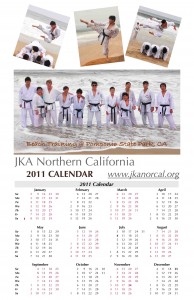
Over the summer, we also took time to participate in some local events building ties with our martial arts community and introducing more of our students to “special training”. Well done everyone – glad to see you all exploring new experiences.
We have been keeping up with our planned curriculum with John Sam’s 2nd Series of Conditioning this year when summer ended. As well lots of basic training (as prescribed by Sensei Kurasako over the summer) preparing for KYU and DAN examination.
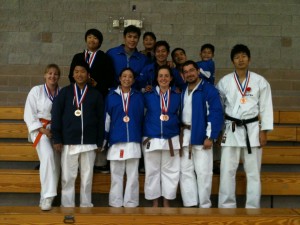
The results can be attested at our recent Fall Belt Promotion and League on October 16th. Congratulations, everyone showed marked improvement and good spirit at the league. Check out the results on our blog with more pictures posted.
Upcoming next is an awesome camp in Miami, FL with reknown JKA instructor Shiina for a week! He returns for an encore camp at Miami Shotokan Karate Club and the Univ. of Miami from 10/26/10 – 10/31/10 (for only U$150) info. A year ago April, Shiina Sensei was here in the US (to get a taste of last year’s event, see blog). This year, he comes to the US again after a camp in Canada. And stay tuned for this year’s blog on this exciting event! 
What better way to train … And right in time for our 2010 JKA AF National Tournament upcoming November 13th-14th at New Orleans. Have you booked your flight yet? Check out the details for JKA NorCal itinerary. Join us!
We are gathering a team from JKA NorCal to participate in 2010 JKA AF National Tournament held at the University of New Orleans the weekend of November 13th – 14th. Please let Sensei Khim know if you are interested in joining us.

Registration Packet. All registrations are due to JKA AF, postmarked by 10/30/10.
FLIGHT DETAIL:
Thu 11 NOV DELTA 4782 LV SAN FRANCISCO 810P
AR LOS ANGELES 926P
Fri 12 NOV DELTA 1006 LV LOS ANGELES 1248A
AR NEW ORLEANS 628A
Mon 15 NOV DELTA 1018 LV NEW ORLEANS 1115A
AR ATLANTA 147P
Mon 15 NOV DELTA 2349 LV ATLANTA 305P
AR SAN FRANCISCO 525P
HOTEL:
Group rate negotiated use “JKA AF” promo code. But need to book by 10/29/10.
Ramada Limited Metairie
2713 North Causeway
Metairie, LA 70002
(504) 835-4141
CONGRATULATIONS to all who passed their KYU tests this past weekend:
(1 ) – KIM MASAYUKI TORRES
(3 ) – JUSTIN HUWE
(3 ) – BRIAN LEE
(3 ) – PATRICK LEE
(3 ) – GARREN LUM
(3 ) – AUDREY DURAZZO
(4 ) – CHRISTIAN LEUNG
(4 ) – ZURI YIP
(4 ) – WILLIAM URRUTIA
(4 ) – IVAN ALVARO
(4 ) – DEVON RAMOS
(5 ) – JACK HICKEY
(5 ) – IRMA SCHLEUSZ
(5 ) – GABRIELLA SCHLEUSZ
(5 ) – BRENDAN BROWN
(5B) – AIDEN DENTON
(5B) – SOPHIA ALARAJ
(5B) – MELINA SHAPIRO
(6 ) – ALI ALAOUI
(6 ) – DOREEN BAIRES
(6 ) – SONNY BATASIN
(6 ) – CARRIE LEI
(6 ) – ASHER WHITTEN
(7 ) – CAMERON COWAN
(7 ) – LIAM MCGRATH
(7 ) – JACOB HUEY
(7 ) – ADEL GHEZARAT
(7 ) – LILI GHEZARAT
(8 ) – MATTHEW STENSEN
(8 ) – JOSEPH CAROL
(8 ) – COLE CHRISTIE
(8 ) – BRIAN LEE
(8 ) – MAX GAINES
(8 ) – ANDREW LUTZ
(8 ) – JOSEPH CLARDELLA
(8 ) – EVAN WALKER
(8 ) – LUCY BALLINGER
(8B) – BINGXI CHAN
(8B) – IVAN HORNUNG
(8B) – ALEXANDRA PALMETER
LEAGUE RESULTS:
KATA
WHITE Belts (1st) Lucy Ballinger
(2nd) Joseph Carol
(3rd) Joey Clardella
YELLOW Belts (1st) Jacob Huey
(2nd) Lili Ghezarat
(3rd) Adel Ghezarat
ORANGE Belts (1st) Carrie Lei
(2nd) Asher Whitten
GREEN Belts (1st) Irma Schleusz
(2nd) Gabriella Schleusz
(3rd) Melina Shapiro
PURPLE Belts (1st) Justin Huwe
(2nd) Garren Lum
(3rd) Audrey Durazzo
KUMITE
PURPLE/GREEN Belts (1st) Ivan Alvaro
(2nd) Audrey Durazzo
(3rd) Garren Lum
(3rd) Zuri Yip
Here are the photos from the Karate Examination, courtesy of Kore Chan:
More can be seen at link
To request a copy of any image, please email Kore Chan at photographer[at]korechanphotography[dot]com
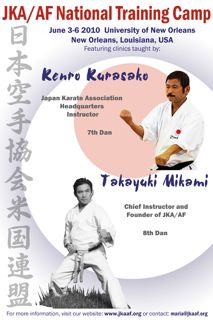
In early June, JKA AF invites JKA instructor Sensei Kurasako (7th Dan) to 2010 JKA AF National Camp in New Orleans, LA (June 3-6). We are privileged to have elite JKA instructors here in the US each year to promote the high standards of traditional Japanese Shotokan karate. Sensei Kurasako is one of the respected Vice General Manager of Technical Division. It would be most enlightening to learn from him and understand his perspective of the art. This event, open to all martial arts organization, will offer learning opportunities from high level instructors as well as qualifications to JKA certifications for Dan ranking and Instructor – Judges – Examiner grading. Above all, a wonderful venue for karate-kas to build community in a learning environment!
For our west coast karate friends, Sensei Kurasako will be stopping in the Bay Area on his pacific route back to Japan for a 2-day JKA NorCal Summer Seminar (June 12-13). Check out the details for this event.
There has been few and far between opportunities for us karatekas here in the Bay Area to train with these elite JKA instructors locally. Most of the time, it is only afforded by those who have the time and resources to travel to the various national camps around the country and internationally. JKA NorCal aim to lean on JKA AF’s annual national camp and invite Sensei Mikami with visiting JKA headquarters instructor here to the SF Bay Area during their scheduled USA tour each summer. The plan for our Annual JKA NorCal Summer Seminar is a 2-day curriculum with classes for both students and instructors (June). Our venue/event will be a smaller setting and likely a more personal experience than a typical week-long camp. We are encouraging all our karate friends in the area to attend – it will be a program that will allow students and instructors to train with and meet our JKA instructors. We also hope to provide a memorable visit for our guest instructors – especially showing off the sights and scenery here in beautiful Bay Area!
We’ve just concluded a successful seminar … thanks to everyone who participated! Stay tuned for more exciting events with the JKA …
An Excellent weekend of great instruction, camaraderie and training …
Here are more pictures of the Sensei(s) in our classes:


Our seminar was just a sample of JKA AF’s annual national camp in New Orleans last weekend. Nonetheless, we are happy to host the Sensei(s) here in the Bay Area and share the good instruction with our fellow karate-kas here in the Northern California.
We worked on “Kihon” (Basics), “Kata” (Forms) and “Kumite” (Sparring) techniques. A call out for us to work on keeping our hip position at consistent height level throughout our katas and more attention on “Zanshin” (the perfect finish) in kumite.
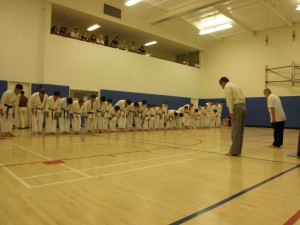
CONGRATULATIONS to all who passed their JKA Qualifications, DAN exams and KYU tests:
KHIM TORRES (“C” Instructor)
CHRISTINA FOO (“C” Judge, GODAN)
JOHN SAM (SANDAN)
EMERSON MALOLOS (SANDAN)
HIDEAKI HAYASHI (“D” Judge)
PATRICK BURNS (NIDAN)
SHIN IKUNO (NIDAN)
KORE CHAN (NIDAN)
BRIAN NG (SHODAN)
BEN DONES (SHODAN)
JIMMY DONES (SHODAN)
(1B) Kym Masayuki Torres
(2 ) Esteban Arcaute
(4 ) Brian Lee
(4 ) Patrick Lee
(4 ) Garren Lum
(4 ) Camri Stuhler
(4 ) Ciara Stuhler
(5 ) Ivan Alvaro
(5 ) Scott Fedorchak
(5 ) William Urrutia
(5 ) Zuri Yip
(5B) Devon Ramos
(6 ) Bethany Dean
(6 ) JunJun Chan
(6 ) Patrick Hoskins
(6 ) Joseph Lee
(6 ) Gabriel Sherr
(6 ) Cherilyn Yu
(6 ) Christopher Yu
(7 ) Doreen Baires
(7 ) Sonny Batasin
(7 ) Danny Keh
(7 ) Carrie Lei
JKA Instructors: Sensei Takayuki Mikami (8th Dan) and Sensei Kenro Kurasako (7th Dan)
VENUE: Burlingame, CA (@ Prime Time Athletic Club) Click here for directions.
All Ranks and Black Belt class in the morning ($50* – if you are a black belt you can stay for both classes)
Instructor class in the afternoon ($20*). Black belts only but you do not have to be an instructor to attend. This class will instructional based focusing on instructor’s training.
* Please pre-register for Saturday classes which will include a day pass to Prime Time Athletic Club ($20 value) your pass will be held at the reception for you. Email info@jkanorcal.org to pre-register. We will email you forms and instructions for you to mail check to our dojo or print out these JKA NorCal Summer Seminar Registration Forms and mail to JKA NorCal to pre-register.
Otherwise, walk-ins on that day you will have to pay for the day pass directly to Prime Time at the reception as well as the seminar fees to JKA NorCal for the classes. Spectators, please pay at the reception $20 for a Prime Time Day Pass to get in.
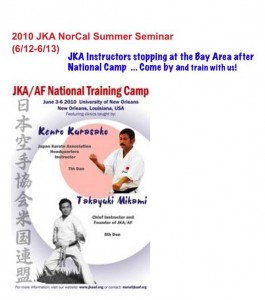
SCHEDULE OF EVENTS:
June 12th: (Sat)
9:30 am – 10:45 am All Ranks Class (Sensei Kurasako)
— 15 minutes break
11:00 am – 12:15 pm Black Belt Class
1:00 pm – 2:30 pm LUNCH SOCIAL with the Sensei(s) – Tribu Grill, San Bruno, CA
3:30 pm – 4:30 pm Instructor Class (Sensei Mikami)
6:00 pm – 8:00 pm DINNER SOCIAL with the Sensei(s) – Dinner @ Steelhead Brewery in Burlingame, CA
June 13th: (Sun)
9:30 am – 11:00 am JKA NorCal Kyu & Dan Testing (Sensei Kurasako and Sensei Mikami)
12 noon – 5 pm PICNIC SOCIAL with the Sensei(s) – NAPA Valley
Mark your calendar! This year’s JKA AF National Camp is going to be from June 3- June 6th at University of New Orleans, with guest instructor Kurasako Kenro Sensei from JKA HQ, along with our Chief Instructor, Takayuki Mikami Sensei. It’s going to be a GREAT camp, with training, qualification exams, dan exams, and more!
VENUE:
New Orleans, Louisiana
June 3rd:
Registration check in
Training from 6 pm till 8 pm
June 6th:
Events to end no later than 1 pm
(give or take a few minutes).
Dan test: up to Godan
Qualification exams: up to B judge, B instructor and C examiner.
For more information and to download the camp registration packet, please see JKA AF member site http://jkaaf.org/member/
So far, Sensei Khim, Christina, Hideaki and John Sam are going to this event. If you are interested in coordinating travel plans. Here is our flight itinerary:
Thu 6/3/10 AA548 6:00am SFO DFW 11:30am
AA1292 2:25pm DFW MSY 3:50pm
Sun 6/6/10 AA 1575 7:00pm MSY SFO 11:40pm
 I was just in time for registration before the first training class begins at 3pm. So thankful my karate family extended the local rate of £100 for the 4-day seminar when I presented my JKA passport (a savings of £10 yeah!). Makes a difference when you are scrounging in your uncle’s wallet for cash as you had trouble with the local ATMs.
I was just in time for registration before the first training class begins at 3pm. So thankful my karate family extended the local rate of £100 for the 4-day seminar when I presented my JKA passport (a savings of £10 yeah!). Makes a difference when you are scrounging in your uncle’s wallet for cash as you had trouble with the local ATMs.
2:45p The Sensei(s) were already there and were warming up at the front of the class. Our host Sensei Ohta received a steady stream of congratulatory handshakes from his students for passing his 7th Dan grading 2 weeks ago at JKA Spring Camp in Tokyo, Japan. Sensei Naka, Sensei Osaka and Sensei Mori with their film star and celebrity martial arts status were going through their ritual of stretching before training just like the rest of us. Classes began promptly at 3pm.
The 3-hour training session each day were structured as follows:
1st hour – General all ranks class (GEN)
2nd hour – Kata class, divided into 3 groups, black, brown and color belts (KATA)
3rd hour – Instructor class for 3Dan and above (INST) others continued with kata
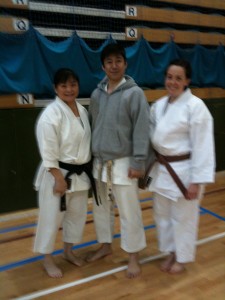
(GEN) Sensei Naka began with “posture”, explaining how critical it is to ensure the best delivery of technique and the engaging of proper muscles. He stressed on the importance of maintaining a center axis that runs from the top of our head down our spine to the floor. He had us stand on our tippy toes and bend our knees at a squat without breaking our center axis posture from head to spine. Next, stand back up slowly on our toes without breaking balance and slowly lower our heels to the ground. Now try it again with your eyes closed – it really brings to conscious the effort needed to maintain posture in order to keep balance! He then went onto explain the dynamics of kicking. He had us do several exercises on the floor that helped us track the path of our kick, extend our foot to target and snap back on the retraction. Quite interesting was an exercise doing a “pelvic lift” while lying on our back with our knees bent and hands to our side (like a bench press on the floor). It is supposed to strengthen our gluteus with which we rely on to extend our kicks. He then had us kick one leg at a time from the floor at this pseudo bench press position that concentrates on pushing the gluteus forward to develop the muscle.
(KATA) Sensei Mori worked on ” bassai dai” with the black belts. He emphasized on big motions for the delivery of each technique. He stressed on “zanshin” – focusing on long pauses on key parts and coordinating eye/head position on certain moves. He worked on us to get it to a power house kata.

(INST) Sensei Ohta taught his trademark “gojushiho dai” (per their newsletter). And I can certainly tell why – he had a very effective way of teaching it in less than an hour. First by breaking the kata into parts beginning with “in place” working on upper body motions and then integrating with lower body in motion putting the kata together. All throughout the process emphasizing the nuances of this form – wrist position, target, ending techniques at the same time and rhythm. My litmus test? I actually got it and that awfully painful turn in cat stance? I actually learnt how to do it without breaking balance and killing my ankles. The real treat was Sensei demonstrating the whole kata at the end of class with his signature rhythm and focus! Inspiring.
My legs were jelly at the end of training – can’t wait to see what tomorrow brings. In the meantime, got my luggage back to the Travelodge, grateful for a ride from new karate friends at the camp. A much needed shower, dinner, 3 advils and a good night sleep to be ready for Day 2.
Day 2: 5/1 (Sat)
Walked to the leisure center with the irish contingent in the morning. A good 20mins later, I’m warmed up and ready for class.
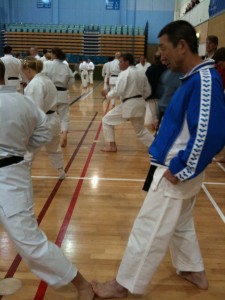
(GEN) Sensei Osaka continued with “posture”, focusing on the knee up position when delivering the front kick. He reminded us that the leg tracks the same way for close distance as well as further away. It is the hip position that thrusts forward to bridge the gap. Watch for the common mistake of leaning back (disrupting the center axis). We should crunch the abs when lifting the knee up. He had us partner up and hold hands in front stance supporting each other while simultaneously lifting our front knee. Phew! Not easy. Then continue to snap kick front leg without leaning back and then back leg. Next, we worked on maintaining posture in hamni position together with hip action. From yoi, step forward front stance rising block, then in position other arm rising block snapping hip to hamni. In position kizami zuki (front arm jab) then gyaku zuki (reverse punch). Next, stance practice – step forward oi-zuki front stance, step side empi in kiba-dachi followed by step back knife hand back stance. He stressed on hikite (draw hand) power when executing each technique.
(KATA) Sensei Naka worked on “kanku dai” with the black belts. Such elegance in his demonstration and eloquence in his explanation for the form we all know so well and yet able to rediscover again from Sensei on practically each move. One hour is barely enough!
His first point on the back stance – it is not a step out to back stance but relaxing your support leg letting gravity drop you into the back stance maintaining weight on the supporting leg (keep center axis spine straight). Next point, the hikite hand on the chest angles upward coordinating with the jodan arm position. This is to maintain balance. So in the case of a knife hand block in chudan arm position, the hikite will be at a lower angle; the same would apply for a gedan arm position (like in gojushiho sho or Chinte) the hikite arm would angle toward the floor. Thereafter he cleared up a point on the double feet pivot position (where we punch and chudan block) – we should not pivot in place but rather pivot on our heel shifting body position off the line of attack. Else we will still be in the line of target (say for a dagger strike). Makes good sense. He also stressed the importance of maintaining the draw arm position tight against our body for the side kick to ensure the kick tracks to a proper angle with balance (this also applies for the other 2 side kicks in this kata). Thereafter the pressing block to spear hand should be delivered as though were one technique. The next move on the turn reach hand strike has to be executed in one fluid circular motion, not broken into 2 moves setup-and-strike. This is because he called the set up point a “dead point” that breaks up the power of the technique. After the kicks on the empi, he says not to drop into the strike (which disrupts the center axis posture) but relax the support leg momentarily to thrust forward to the front stance when completing the empi attack. Then, on the last haito-back fist strike, the hand motion tracks in front of the body in a circular wheel motion, not from the top of the head nor the side of the ears as a common bad form. Next point is the lunge position, the back heel is down in kanku dai as opposed to up in kanku sho. Recovery on the turn is a lower than normal back stance that maintains the stride of the lunge. The next back stance is a normal stride for kokutsu-dachi. On the series after the kick and spear-hand, the body should move toward the twist block behind the ear instead of retracting the arm towards the body moving into kiba-dachi. This is because the self defense in this move will not generate enough power to get out of the hold by only using the arm but rather moving forward to break the balance of the attacker at the same time thereby wrenching the arm out of the hold to strike. The back fist strike should be with arms bent in a close position not outstretched. The next chudan strike is extended. Next, for the step through kiba-dachi turn, he reminds us to keep arms close to body when directing the focus on the scoop block. Lastly, the double rising X-block, maintain the wrist together through to the kicks and keep upright body posture on the turn for the finish. Wow! How about that for fine tuning kanku dai.
(INST) Sensei Naka was just charming in this session. Charming and thought provoking with the class. He tossed out the notion of being “instable” in our kata to deliver power and execute technique. Explained the nuances in delivering a punch with a braking hip action (hip rotation), a double hip action (like in hip vibration) and even a triple hip action – we need to practice and discover what works for us. We worked on tekki shodan and tekkie sandan to practice. Many of us trip on trying to think too much doing our kata. We should train for the budo of doing kata without thinking (body memory). Just like trying to trace a triangle with one hand and simultaneously tracing a circle with the other, it takes practice to do so (like kata). Try it. We worked on a series of one arm techniques. He had a drill to step forward oi-zuki, same arm soto-uke, same arm block back fist (like tekki) and choku-zuki. It takes coordination to resist the urge to use both arms alternatively. It is a challenge when paired up with a partner who is attacking at full speed after blocking your first strike with age-uke and returning with chudan reverse punch and jodan choku-zuki and another chudan reverse punch.
He had some fascinating demonstration/thoughts ….
1. When we move forward and extend our arm, we direct with the index or pointing finger; when retracting, we initiate with the ring finger (as in making a fist). This same focus can be applied when we punch directing with index finger and retract for hikite contracting the ring finger)… Interesting concept.
2. Extend your arm with palms open facing downward, when making a fist, do you curl your fingers back into your palm? Or extend your palm forward into your fingers? which is stronger? Surprisingly, the latter (we tested with our partners in class). He talked about the dynamic of the shoulder blade position being better able to support the arm at the joint and fascinatingly also extends the length of our arm.
3. He showed us how sport karate (jumping around in kumite) destabilizes us and is much weaker in sustaining a hit compared to traditional martial arts (heels are on the ground). We also tested this with our partners in class.
4. Sensei demonstrated rotating his hip using upper leg (thigh muscles and hamstrings) while keeping stable the lower leg grounded to the floor, so effortless and completely mesmerizing!
It is a privilege to learn from these elite JKA instructors who spend so much time fine tuning the art and Naka Sensei seem to really enjoy sharing his discoveries and his learning moments with us in the community of karate-kas.
Day 3: 5/2 (Sun)
The Sensei(s) were in good spirits this morning, mingling among the crowd to give some tips to the student and for photo ops. We had a chance to take some pictures of our own (Silvia and I). More importantly, I was able to ask clearance from Sensei Mori for his dojos (especially from the Bay Area) to participate at our June Seminar featuring Mr. Kurasako (6/12). Yeah for our friends at UCSF and Stanford!
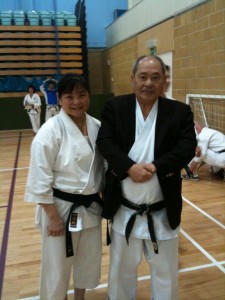
(GEN) Sensei Mori also continued on the theme of “posture”, stressing on hikite for both punches and kicks. He kicked off the class with double draw hand to the waist from outstretched jodan joined fist position. We are reminded to keep the back of the. fist parallel to the floor for our draw hands at the waist. He had us paired off and our partner check the position of our draw hand for stability. And for us to affirm the draw hand power compared to that with loosely held elbows.
(KATA) Sensei Osaka worked on “jion” with the black belts. First point on the 2 kicks – knee up position without leaning back and follow through without pause (use gravity and kick retraction to generate speed). Double fist position is slightly angles (check by making knife hand block then close fist). Next, the 3rd age-uke with step in oi-zuki is delivered as though one count without stopping. Next 2 kage-zuki should be done without a setup draw hand (only for teaching beginners) but rely on hikite and tension on supporting kiba-dachi to generate power. The 3 teisho (kidney strike) should not be a pushing movement but with a slight outward inside swing. Reminder on the next back stance to lower into the stance (like kanku dai first moves) instead of stepping out. Important note on the “X” block is tracking the proper arm motion and full extension instead of the worrying about the power and the step; double chudan block not jodan and open hand “X” block is high enough to cover your head. The next 2 inside block should end in hamni and the important note is angle flexibility for a smooth and quick step into the stances. The last 3 series of chudan blocks in kiba-dachi should not have open hand during the moves. All open hand techniques should have a purpose (as in double manji blocks) – do not create a move for open hand without meaning. Implement update on the kata for the last 2 moves where arms set up crossing arms in front of body with open hand for pulling arm.
(INST) Sensei Mori was fiercely passionate that the higher ranks and instructors lead by example the good spirit of training and higher excellence in execution of techniques. He focused on “hikite” for both arms and legs (as in kick back). We did a series of drills for kiage and kekomi to concentrate on proper form. We then worked on “tekki nidan” and went onto drills to practice timing of “sweep” technique.
“Hey,the course is fantastic, even the Americans turn up! “ ~ new friend in JKA England
GRADING EXAMS: Kyu tests were done yesterday. Today’s Dan tests for 3rd Dan and higher were closed doors only open to JKA qualified examiners.
Day 4: 5/3 (Mon)
Last day of training. Everyone seem to be here a little earlier. Sensei Ohta had each country gather to take group phots with the instrructors. The Sensei(s) are all so very accommodating taking pictures and signing posters. Norway had a huge contingent. USA were only the 4 of us (2 from Boston and 2 of us from SF). Friends were excited exchanging contacts … A successful event with a well planned curriculum~
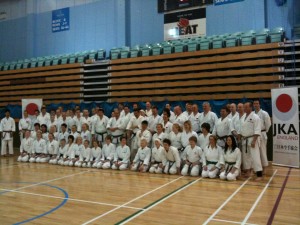

(GEN) Sensei Naka closed on the overriding theme of “posture”. He had a few more exercises to remind us of our center axis and how to leverage momentum and gravity to deliver our techniques with speed and focus. Very important is to work on our flexibility of the ankles. One challenging exercise with a partner – hold hands outstretched with partner, feet together bend knees with body upright (modified yoga chair move). Then step away from partner without holding hands, get into the stance again without falling over. We reviewed the back stance (refer to kanku dai class), maintaining height as we transition from back stance shifting weight to turn and face back direction. Another drill – step back right leg into back stance, turn facing the back and turn again facing front (3 kokotsu0-dachi); kiri-kai retracting the back leg (rt) and step back with left leg into another back stance and end with shift into front stance reverse punch. Next initiate with left leg. The key is to progress to a faster transition on the kiri-kai without stopping but almost dropping into the last kokutsu-dachi (using gravity) to generate speed. Awesome drill!
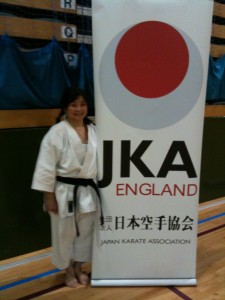

(KATA) Sensei Ohta worked on “empi” with the black belts. He showed us how to insert hip action into the first down block into the kiba-dachi kage-zuki. He reinforced on points reviewed by Sensei Osaka’s general session and helped us apply it to this kata. He reviewed how to generate the sharp hip movements throughout the kata from the rising punch (braking hip like in reverse punch) to the next gedan berai setup (hip vibration into hamni position) as well as the double punch in kiba-dacho (hip vibration). Attention to the move before kiai – hand and leg move in synchrony with target arm at 45degree angle jodan position to the front. Next, the series of heel palm blocks has to be coordinated with step forward front stance focusing on ankle flexibility and ending at the same time. For the jump turn, we should aspire to get our knees to the chest for the turn. Great stuff!
(INSTR) Sensei Osaka worked on “sochin” and “nijushiho” in the instructor class. (to be continued later).
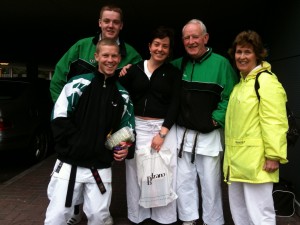

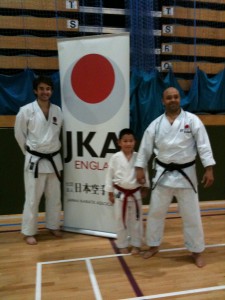
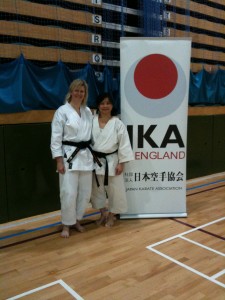

It is Spring and the start of camp season through the summer (April – August). You may already have plans or balancing your schedule deciding which events to participate (karate camps, summer camps, family vacation … always a struggle … so much to do, so little time). For me, mine begins somewhat close to home in PHX with an invitation from Sensei Coburn to join in their Spring Karate Do training with Sensei Yaguchi and Sensei Fields.
 I received a heart felt personalized email from Sensei Coburn earlier in the year with images from when I last attended a couple of years ago, asking me when I will be returning again. OMG, Sensei “email marketed me” … and it worked! It reminded me of the fun I had then and the people I enjoyed training with. Immediately I made plans to go.
I received a heart felt personalized email from Sensei Coburn earlier in the year with images from when I last attended a couple of years ago, asking me when I will be returning again. OMG, Sensei “email marketed me” … and it worked! It reminded me of the fun I had then and the people I enjoyed training with. Immediately I made plans to go.
Thu (4/15) : Thank heavens I filed my taxes a couple days ago so that I can freely enjoy the camp. A smooth travel from OAK-PHX, heading straight to dinner upon arrival (what a perfect way to start camp right?!). Reconnected with karate family: Sensei Yaguchi, Sensei Coburn, Cheryl, Jeff, Joan, Fred, Eli and Sergei at Yoko’s family restaurant Cherry Blossom. Good food, sharing good cheer and reminiscing about karate stories. The highlight was browsing through Jeff Heermans’ Vail Shotokan Karate website and enjoying the wonderful tribute that Sensei Cathy Cline put together for Sensei Yaguchi’s 77th Birthday on uTube.
Fri (4/16): Early morning 7:30am optional class with Yaguchi Sensei at Shotokan Karate of Arizona dojo. As usual, an awesome class! Such attention to detail, great foundational principles for shotokan karate. Sensei need only give me a look and I understand and know what he wants me to self correct …
He reminds us the difference between “MAKE technique” and “USE technique” – how in training we should pay attention to proper form and execute correctly thereby MAKING the technique to ensure safe training and pushing for our full potential to the form; while in kumite or with partner, we will naturally find the opening and USE the technique for best delivery depending on the situation. Alot of emphasis on the KNEE POSITION. Our individual BODY WIDTH should be uniform in all our stances as should be the tension – what differs in the stances is the knee position (he demonstrated with front stance, back stance, sochiin stance, hangetsu stance and sanjin stance). He also called out for upper body WEIGHT DISTRIBUTION to be a tad (2 degrees) forward which will best prepare for forward moving momentum. We reviewed Heian Nidan empahsizing on these points.
When teaching one of the drills, he took the time to break down in rudimentary details … (1) stand at open natural stance; (2) in place bend both knees; (3) in place twist body 45 degree to the right; (4) retract right foot tracking half moon motion to the back – end at left leg front stance position; left arm raised to rising block position (5) slight rotate right knee while pushing right hip forward delivering right hand reverse punch. Are you following? Starting from “yoi” four counts on this drill eventually executing to one count for a “smooth delivery” for this step back right leg rising block reverse punch from yoi technique. Note: smooth delivery means step and punch ending at the same time! Can’t wait for next class at 5:30pm …
Sensei reinforced much of the same principles reviewed at the earlier class for the general class. He highlighted the importance of moving as one unit leading with the hips. Good posture by aligning shoulder joint, hip joint and knee joint – grounding power downward in forward motion for stability and power. We spent much time on the Back Stance – paying attention to knee position and knife hand position being no more than a fist distance between elbow and rib; fingertips no higher than your shoulder. We then reviewed Heian Sandan in detail – challenging physically the form and mentally focused doing it in opposite direction.
Sat & Sun (4/17-18): Sensei worked on FUDO-DACHI- it begins with a body-width kiba-dachi stance in a 45 degree angle (feet) but with body completely front facing; knees outward tension with weight slightly towards the front. We had quite a few combination drills to practice. Then we reviewed CHINTE. Points for CHINTE: The essence is in the transition from fudo-dachi to zen-kutsu-dachi (it has to be quick and sharp, keeping same height during transition). Alot of large circular moves in the techniques for this KATA.
Move #1 in a course of rising block, ending with arm outstretched but slightly bent, fist no higher or lower than shoulder. Retraction in Move #2 bumps left fist at chest to initiate next rising block course to opposite direction. Move #3 drops to a kiba-dachi and double arm rising block (need to drive course with elbows close to body, finger tips slightly overlapping). Next 2 moves are fudo-dachi to zen-kutsu-dachi with arms outreached using ta-te-uchi as target for reverse punch (do not grab fist). Kiai on the empi for the third series (also do not grab elbow-just target). Following that, a quick transition to back stance. Another back stance then jodan migeri in place (do not stand up, keep height even) with double arm block (inside uchi-uke and gedan berai) like Heian Sandan with body facing completely front. Next move initiates with a twist of the right forearm for a gedan inside block follow through wide circular track over the top to end at gedan outside block. Note the arm blocks have to coordinate to end same time as left leg steps forth to stand up feet together upright. Next two circular blocks begins with arms (tracking like “ferris wheel”) first and as arms come around to the last quarter round, shift in kiba-dachi back the opposite direction. Following that, the double inside block (chudan) shifts same time to the left. Next slow recovery to the one-legged stance with double arm gedan berai on the both side of the body. Note, not to double block but move directly from uchi-uke to gedan berai. Descend next to front stance one finger strike (in circular motion) followed by other arm one finger strike on top of right top of hand (end with body front facing). Next two-finger uchi-uke is executed in place with focus using hip vibration to body hamni position (chudan). Then step forward front stance with two-finger rising punch. Step back turn around deliver the same block and attack to the back. Change direction to a fudo-dachi outside in right palm strike, in place left palm strike to meet right palm (paper distance gap) transitions into front stance. Then in place double gedan berai to the sides of the body (much akin to pulling motion in Jion). Next turn around double kidney strike in a bear hug position to fud0-dachi (fists body width apart). Use back muscles to to round shoulders on the strike for focus. Smooth transitions on the next two series of fudo-dachi to zen-kutsu-dachi target punches. Finally, retract to standing stance and “skoot” back three times (not hopping but feet brushing on the floor) to end with bent knees straightening up. Feet open on formal “vee” on the bow for balance.
Other Principles: Sensei talked about Omoto-Waza and Ura-Waza (front technique and back technique) executing in balance as “best technique”. He also called out the importance of being “on target” and how the precision of target differs in Kata and Kumite. For Kata, there it requires for point precision. For example, there is only one spot for Chudan (solar plexis) while for Kumite, any spot on the torso counts for Chudan. Therefore for Kata if we strike “out of target”, it is not a “mistake” but points will be deducted for “bad technique”. When attacking, we initiate with the “goal/intent” of striking through your opponent but having the “control” to end just paper distance before.
Other Kata(s) reviewed: Bassai-Sho, Empi, Jion, Kanku-Dai